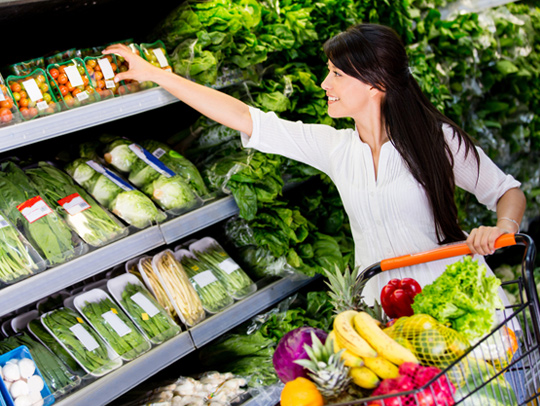Branding, Local and The Future of Produce: University of Georgia’s Ben Campbell Speaks Out
December 8, 2021 | 9 min to read

A favorite research presenter at the New York Produce Show, Professor Ben Campbell will be sharing new research findings on the value of brands in produce, as well as the importance of local in the buying decision. Ben Campbell, an associate professor and Extension agricultural economist at the University of Georgia, Athens, GA, will be speaking at the NYPS Wednesday, Dec. 15, 2021. He recently spoke with Susan Crowell, Contributing editor at Pundit sister publication, PRODUCE BUSINESS magazine, about the new research and its impact for the produce industry.

Ben Campbell
Associate Professor and
Extension Agricultural Economics
University of Georgia
Q. You’re a repeat presenter at the New York Produce Show and conference. You’ve won wide acclaim for incisive and intriguing presentations. What research highlights will you be sharing this year?
A. We conducted a new survey at the beginning of 2021, looking at the value of brands in produce, as well as the importance of local in the buying decision. I’ll be sharing the research findings for the first time at the New York Produce Show, including a comparison among produce, plants, food (nonproduce), nonfood and wine.
Produce isn’t really branded, and we were curious about branding across produce, and to see if brand matters to consumers. And then on top of that, we were interested in buying local — how much does buying local for those different product categories play a part of consumers’ shopping decisions.
Are there segments of the population that value brands for some things but not others? We were interested to see what kind of market segments could pop out of this, to see how valuable is produce. Do consumers think brands are important to produce? We were just trying to better understand branding within the produce category.
I’ll also be talking about a mix of things on the market, including impacts of the coronavirus.
Q. Tell me a little more about the survey.
A. We did a survey of about 4,000 people in the U.S. One of the questions we asked was, “How important is buying name brand products when you purchase X (for example, produce)?” We had a scale of ‘unimportant’ to ‘very, very important’ — basically, a 100-point scale, with 50 being neutral and anything above 50 being an important trait, with 100 being extremely important. We also asked, “How important is it to buy local products?”, and another question was “How comfortable are you having someone else select the following products for you (online store)?”
Q. And what did you learn?
A. So in regard to the first question: How important is buying name brand products? The food category came out on top, at 59 on our scale, and produce was a 57. If you’re looking at the importance of buying local, produce was by far the most important thing, at 70, — so respondents valued local for produce over anything else — and second was food at 64.
We also wanted to see how the coronavirus impacted the importance of buying local, and in the answers to our questions, produce was again the highest. The pandemic actually reaffirmed people’s desire to buy local produce. That probably came out because people saw shortages, and they were worried. So reaffirming that ‘local is important to me’ — well, it’s even more important, given that there’s some kind of shortage in the system. Even though it may not have been affecting produce, it was still on their minds.
Then, we did some clustering to see what kind of branding segments are out there, and came up with eight segments. Three of them are really important to produce. You have one that highly valued brands for produce and food, at 5%. Secondly, you had a produce-wine group that cared about brands, about 16%. Then, you had a highly sensitive brand group that really cared about brands across the board and their scores were in the 80s and 90s for all products, at 18%.
So, you’re looking at 40% who had produce at 70 or above on that scale, who cared about brands — 40% of the people out there care about brands for produce.
Q. What else did you find out about this 40%?
A. These people are buying from grocery stores and supermarkets — and these brand groups tend to be higher income, and tend to be younger, not older. Except the older shoppers are more likely to be in the produce-food group. The younger consumers are more likely to be in the other two groups that care about brands.
The median income of survey respondents was around $65,000. The average income for the group that really cared about brands was about $90,000. The high, high incomes really cared about brands. It didn’t matter what kind of brand, it was across the board — they care about brands.
The produce-wine segment had an average income of $76,000, and then you have the produce-food group, at about $71,000. So the produce groups that care about brands had higher income, and they are more likely to shop at a supermarket or produce store than other alternatives.
As the importance of buying local grew, the more likely these shoppers were to be in the produce brand group.
Q. Let’s talk more about interest in buying local among these brand-loyal consumers.
A. The question I have is, are these local buyers looking for more specific local brands? And I think that’s what’s happening here to a degree — local buyers are looking for certain brands they know to be local. So when you are marketing and if you’re selling locally, branding could be a good way to make inroads, not just with the state branded logo, but also with brand logo with respect to a farm or a specific growing location.
If you brand, you’re building a brand that someone recognizes. You can show them “local,” but they might get you mixed up with someone else local, but if you brand, they’ll come back to you and ask for your product, not just any local product. A lot of it is education — you’re building a reputation for YOU, because you’re local. If you establish your name, and that has value, people ask for you and associate characteristics with you, and thereby they’ll pass just a local product.
Take the Georgia Grown label, for example. You pay to use the Georgia Grown label, that’s great, and they’re using that money to market Georgia Grown, and that will help you. But if you put a few more cents into designing your label or doing other things to showcase, “hey, I’m Producer X or Retailer X, and here is my name, my farm and my product, and I am local,” now you’re showcasing “I am me,” and people are going to start to ask for you, for your product. These people who are buying local are looking for brand.
The next question should be “are consumers finding them?” And I think we answered that, based on other surveys, that the answer’s “no.” One of the big barriers to buying local, is they aren’t finding what they want (local) in the stores.
Q. It sounds like there’s a big opportunity for branding produce, especially to create a ‘buy local’ demand.
If you brand produce, and you develop that brand, retail is now more likely to put you in stores, and they’re also now going to let people look for your product.
People are looking for local. It’s not the main driver for everyone, but it is a driver for a lot of people. To me, local is great, but to have a brand that does that is better, even from a retailer’s standpoint. For example, if I go in after a local product, is the person on the store floor going to be able to say, “oh yeah, this is local.” If I have a brand of a product that is local, now it allows retailers to give people a product that is what they’re looking for.
People are looking for local. Helping to put local products in stores will also help retailers to be more successful, because people are looking for it and they’re going other places to find it. We know from this research there are three, big segments out there that are looking for local. There are three segments that are looking for brands — and produce is one of the big targets. I think we do a bad job of showcasing local produce, and I think that’s a market that we could tap into.
******
Branding in produce has been a conundrum for decades and for two simple reasons: First, in most cases in produce the product itself is identical. It is, for example a Cavendish banana. So differential has to come through care and handling and marketing. Second, supermarkets typically only carry one brand at a time. In other words no supermarket has an intentional display of dole bananas, next to Chiquita bananas, next to Del monte bananas.
This is just very different from typical branding of food products where Campbell’s Chicken Soup is different than Progresso’s and both products are available in most stores.
Although having statistics showing that one’s brand of produce is preferred by consumers may help persuade a particular retailer to commit to that brand, and indeed might result in psychologically pleasing customers who feel good about a particular brand, the unanswered question is two-fold: Is the brand preference in produce sufficient to A) Get consumers to pay a premium for the brand and, B) Is this preference sufficient to get consumers to switch stores to get the brand they prefer?
Recently produce branding has begun to change because of the introduction of proprietary produce. Probably the most highlighted here is Cotton Candy grapes because it offers a distinctive flavor profile. Many other proprietary varieties are focused on superior taste and other attributes.
What we don’t have a lot of good research on is what happens when these proprietary varieties are not available. Does a consumer that was looking for Cotton Candy grapes because the children in the family love the flavor, just buy another grape? Does the consumer buy the children’s second favorite fruit, maybe some kind of mandarin or does the consumer just buy cookies or real cotton candy?
If a supermarket got an exclusive on a product such as this, would that be sufficient to make consumers deeply committed to that chain?
Even more research needs to be done on local. For one thing what does the term actually mean to a consumer. Are California avocadoes “Local” because they are the nearest grown Hass avocados to consumers in Boston?
Do customers actually prefer local, or do they make a bunch of assumptions about what they will get from buying local that makes them think they prefer local. In other words when a consumer hears local they may assume that transportation is cheaper and so the price should be lower. But maybe straight trailer loads from a distant growing region will be less expensive than less than trailer loads from a closer locale – so how will consumer react if the local product is actually more expensive?
In any case this research and presentation addresses important industry concerns and provides valuable insight into consumer attitudes to ware important issues in the produce industry. We hope you join us to learn and engage.
You can register for the workshop by signing up for The new York produce show and conference right here.
Let us know if you want a hotel room at the headquarters hotel by emailing us here.
Of course wea re happy to help and answer any questions right here.
